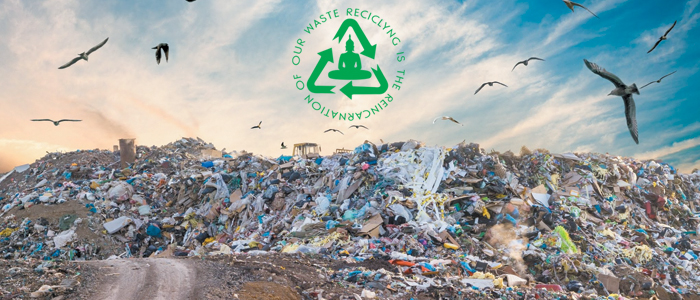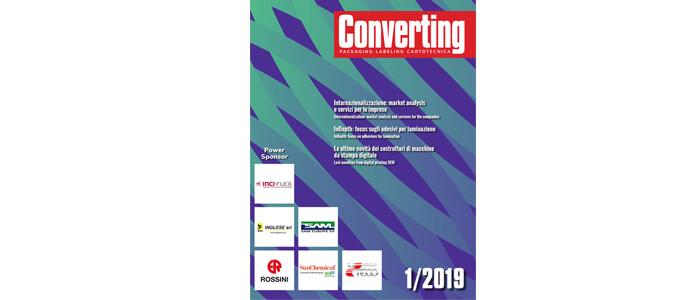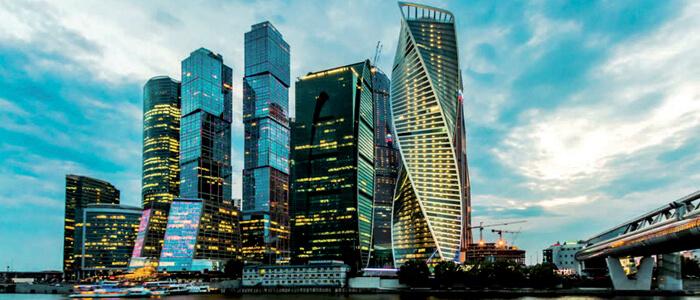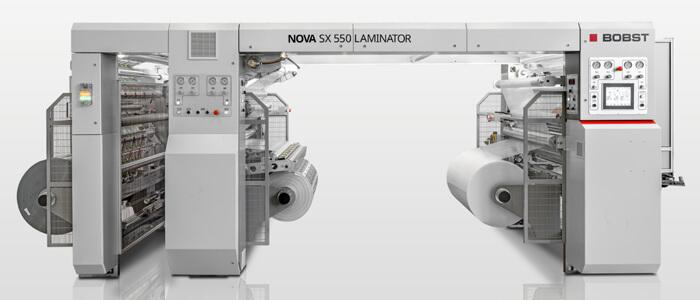Imagine the Buddha sitting under the Bodhi tree with a crowd of entrepreneurs and managers from the converting sector, their clients, product managers and agencies around him.
Now imagine the Buddha in his quiet voice enunciating these simple truths:
- True green packaging is no packaging
- All paper packaging can be recycled
- Not all packaging is equally recyclable (polycouples are a separate story)
- Few are biodegradable (and this must be documented)
- Very few are compostable (and this must be documented)
From which derive these corollaries:
- “Green” means nothing and in nature there is only one perfect and sustainable packaging (see box “The Rule of the Banana”)
- “Sustainable” (if not accompanied by concrete and verifiable data) does not mean anything.
[accordions]
[accordion title=”The Rule of the Banana” load=”hide”]The only true packaging that is perfect from every point of view is that of the banana:
- it identifies the product in a unique way;
- thanks to its unique color and shape, it is perfectly recognizable even among thousands of other products of the same category;
- it signals the expiry date in a simple and easily verifiable way thanks to the black dots;
- it is anti-counterfeiting and anti-fraud: the expiry date cannot be altered;
- it is accessible, i.e. easy to open even for the elderly and children;
- it is recognizable even by the blind;
- it is biodegradable and compostable even in home compost.[/accordion]
[/accordions]
Who does what
I don’t know if the Buddha really has these 5 Truths, but I know for sure that sustainability is a complex issue, a sort of umbrella under which go, in strict order of importance, the environmental policies of the world, of individual states, regions, municipalities, companies and finally the behavior of individual citizens.
If we look at the world report “Climate Change 2021” (Report of WG1 at this link) we see that the responsibility of environmental policies falls mostly on national states, and if it is certainly true that the virtuous behaviors of citizens are important it is even trivial to record that without an effective system of recovery and recycling little we could do individually.
Let’s try to think of the current result in paper recycling, which in Italy has reached the record figure of 87.3%, well ahead of the 2030 objectives set by the European Community, and we can see that this result depends largely on specific legislation and the creation of efficient recovery and recycling plants (Comieco Report at this link).
Two pieces of news for companies
Coming to the corporate world, it is normal that such a fundamental issue makes many managers and entrepreneurs ask themselves “what can I do to contribute ?” Then, if it’s a small or medium-sized company that uses paper packaging, it’s easy to turn to your packaging supplier for answers.
The good news is that a lot of packaging is already “sustainable” or that there are few things you can do to make it so. The bad news is that this assumption is hard to accept.
I understand that it is “sexier” to communicate on your website “our new green packaging” rather than “we already had green packaging but didn’t know it” but this is a simple reality.
So what to do? Where to start ? Now!
[accordions]
[accordion title=”To explain my point of view I will use a (true) Buddha story” load=”hide”]
A woman who was very full of herself went to the Buddha to ask how to achieve enlightenment. The Buddha told her to go to a cave on top of a mountain, there she would meet a Master who would help her on her path. The woman reached the cave and saw inside a sweet old woman meditating. As soon as the woman approached the old woman, she turned into a demon that began to chase her and to beat her screaming “NOW NOW NOW” (Adapted from Pema Chödrön “No way out” Feltrinelli).
[/accordion]
[/accordions]
As the Buddha teaches, we must look at what is now and not at what could or should be, ending up creating an irremediable dualism with reality.
As the Buddha would say :
- “When is the time to help the environment? NOW”
- “With what tools? With those that exist NOW”.
The 3Rs in practice: applications and limits
Let’s talk about paper packaging and let’s try to identify some areas of intervention (to examine them all it would take a manual and not just an article), starting from the simplest ones and then examining more complex interventions.
Let’s start with the classic “Three Rs”: Reduce, Reuse, Recycle.
[accordions]
[accordion title=”Reduce” load=”hide”]
Reducing the volume of a case or a package is certainly a useful intervention, if possible by designing the packaging already in function of the optimization of the pallet. To this end, I would like to point out a very useful free application that allows load simulations to be carried out quickly and efficiently.
If, on the other hand, we want to tackle a packaging redesign process, for example by replacing a multi-material protective packaging with a completely paper-based one, then an integrated approach is needed that thoroughly involves the business functions of both the customer and the supplier. From this point of view, the working method of Deles (www.delesgroup.com) is a model that deals not only with the “shape” of the packaging but also with the entire production and supply process, in order to obtain a reduced environmental impact.
[/accordion]
[/accordions]
[accordions]
[accordion title=”Reuse” load=”hide”]
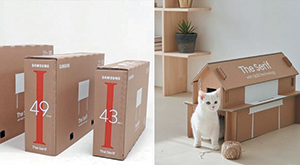 Reuse aims at giving a second life to the packaging and delaying as much as possible the moment it is sent for disposal. There are a number of interesting case histories, including that of Samsung, which for its new LifeStyle range has created packaging that can become a small table or a kennel for the cat (Photo 1). These are certainly important case studies but, in my opinion, they require a very strong investment in research that goes beyond the simple basic idea.
Reuse aims at giving a second life to the packaging and delaying as much as possible the moment it is sent for disposal. There are a number of interesting case histories, including that of Samsung, which for its new LifeStyle range has created packaging that can become a small table or a kennel for the cat (Photo 1). These are certainly important case studies but, in my opinion, they require a very strong investment in research that goes beyond the simple basic idea.
[/accordion]
[/accordions]
[accordions]
[accordion title=”Recycle ” load=”hide”]
This is the area where I think there is more to do, especially in order to efficiently exploit existing recycling systems (….NOW!).
Two areas are of particular interest to me: raw materials and environmental labeling. In the following I will deal with raw materials and environmental labelling in the next issue of Converting.
[/accordion]
[/accordions]
FSC paper and board
In the many posts dedicated to sustainability that I read daily on LinkedIn, I often find the equation “paper/cardboard=felled trees”. This equation does not take into account the existence of paper and cardboard produced by companies that adhere to sustainable forestry programs.
A glance at the newspapers is enough to understand that the direction taken is the right one, as documented in a recent article in Corriere della Sera entitled “Italy and the record growth of forests: one million hectares in 30 years“.
Special papers made from scraps
Lately I have seen the birth of several very interesting projects of paper made from industrial process waste or raw materials, such as grass or tomato peels, which do not involve the exploitation of forests.
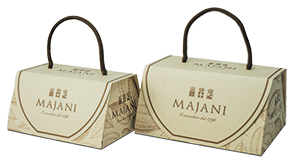 An interesting case is that of TFK® with which Medhea Srl has created a practical pack for the famous Majani chocolate shops. This is a totally recyclable pack printed with food-grade inks and intended to be assembled and used at the point of sale to package loose products. The cardboard is made from sugar cane processing waste (the so-called “bagasse”) and is therefore rightfully among the products that are made from a raw material that does not require the felling of trees and avoids the disposal of processing waste.
An interesting case is that of TFK® with which Medhea Srl has created a practical pack for the famous Majani chocolate shops. This is a totally recyclable pack printed with food-grade inks and intended to be assembled and used at the point of sale to package loose products. The cardboard is made from sugar cane processing waste (the so-called “bagasse”) and is therefore rightfully among the products that are made from a raw material that does not require the felling of trees and avoids the disposal of processing waste.
Although case histories such as these are worthy of note, they remain solutions destined for niche markets and are certainly not, on their own, capable of bringing about radical changes in the system of production and use of paper and cardboard.
Inks, coatings and glues
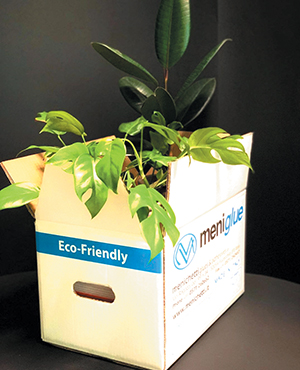 There is a wide range of inks and coatings with low environmental impact on the market. For obvious reasons, I would like to list them, but I would like to give the example of a company that has found a way to create a glue for packaging using waste from tanneries.
There is a wide range of inks and coatings with low environmental impact on the market. For obvious reasons, I would like to list them, but I would like to give the example of a company that has found a way to create a glue for packaging using waste from tanneries.
Just take a look at their website (www.Menichetti.it) to find numerous solutions both plant and animal based. The one I found most interesting is the TDS Meniglue, totally biodegradable and recyclable, designed for paper processing such as the lamination of coated boxes. It adopts the winning formula of the recovery of processing waste that would otherwise enter the recycling circuit, and the exploitation of zero-kilometer resources abundantly present in Menichetti’s geographical area of reference.
Next chapter (and final economic note)
In the next issue of the magazine, I will develop the discourse dedicated to environmental labelling, with a further chapter on the digital label. And now I just add a final note: if the Buddha was not enough to convince you that much can be done NOW, then I add a reference to the economic factor (which sometimes works better than many other arguments). Starting from January 2022, Conai has extended the differentiation of the environmental contribution to the predominantly cellulosic polycoupled materials, even if not intended for the containment of liquids.
What does this mean? It means that any material belonging to category C/PAP 81 or “packaging made up structurally of two or more materials that cannot be separated manually, in which the predominant material in terms of weight is paper and the weight of non-cellulosic material is in any case greater than 5% of the total weight of the packaging” will be subject to a differentiated contribution, depending on the percentage of paper contained.
In other words, seeking solutions to increase the cellulosic fraction of our packaging will also lead to concrete savings in the Conai Environmental Contribution.
by Marco Rotondo

